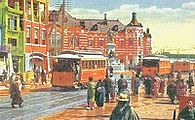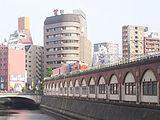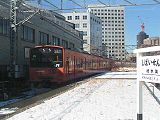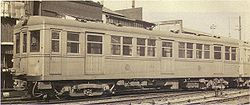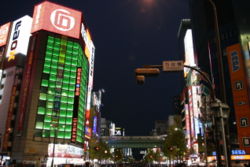- Manseibashi Station
-
Manseibashi Station万世橋駅
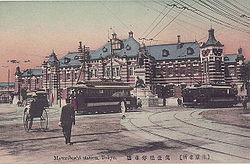
Original building of JGR Manseibashi Station Location Prefecture Tokyo
(See other stations in Tokyo)Ward Kanda History Opened 1912 (Government)
1930 (Underground)Year closed 1931 (Underground)
1943 (Government)Rail services Operator(s) Japanese Government Railways,
Tokyo Underground RailwayManseibashi Station (万世橋駅 Manseibashi-eki) can refer to two closed train stations all in Chiyoda, Tokyo, Japan. One was a railway station on the Japanese Government Railways Chūō Main Line and the other was a subway station in the Tokyo Subway network.
Both stations were closed by 1943, though trains and subway cars still pass through them. The stations took their name from the nearby bridge, Manseibashi. The railway station was located on the south bank of the Kanda River, while the subway station was located on the north bank. The area north of the bridge is known as "Akihabara Electric Town".
Contents
Government railway station
The old Manseibashi Station on the Chūō Main Line of Japanese Government Railways was in the Kanda Ward (now part of Chiyoda Ward), and is located between Ochanomizu Station and Kanda Station.
History
The private Kōbu Railway (甲武鉄道) between Tachikawa and Shinjuku was opened on April 11, 1889. The line was gradually extended east towards the center of Tokyo and was nationalized on October 1, 1906. The line was further extended to Manseibashi Station, which was opened on April 1, 1912 and remained the eastern terminal station of the line for seven years.[1]
The first station building was designed by Tatsuno Kingo in a style inspired by the Amsterdam Centraal and repeated in his design of Tokyo Station, opened two years later. A statue of Takeo Hirose was erected in front of the station.[1]
After the 1914 opening of Tokyo Station, Manseibashi still served as the eastern terminal station of the Chūō Main Line until March 1, 1919, when the line was further extended and Kanda Station opened. The 1923 Great Kantō earthquake destroyed the original station building, and a simpler station building was erected in its place.[1] The statue of Hirose was left standing.
In 1925, the elevated railway running through Ueno Station and Akihabara Station was opened for passenger traffic. Since both Akihabara and Kanda stations were within walking distance of Manseibashi, passenger numbers at Manseibashi decreased. On April 26, 1936, the Railway Museum moved into Manseibashi Station, and the station building itself was scaled back in November 1936. The station was officially closed on November 1, 1943 and the station building was completely torn down.[1] The statue was removed after World War II.
-
JGR Manseibashi Station in the original design. The view is from the street side, looking north-east, showing trams on the street. The Chūō Main Line is on the river side, mostly hidden behind the buildings, but it emerges behind the station building and continues to Kanda in the east (right); this dates the image to between early 1919 and September 1923.
After the closure
The train line continues (as of 2008) to run through the lot, and it is used for parking the occasional train. The Tokyo Railway Museum was made the Transportation Museum in 1971, and continued to operate on the lot until 2006, when the museum was re-focused towards railways and moved to Saitama, Saitama as the Railway Museum.
Subway station
The Manseibashi subway station was on what is now (as of 2008) the Tokyo Metro Ginza Line, situated between the Kanda and Suehirochō stations. It was within the old Kanda Ward, like the JGR station, but on the opposite bank of the Kanda River.
History
The subway line between Ueno and Asakusa, opened in 1927, was being extended southward. When the extension reached the Kanda River, a temporary subway station was opened at Manseibashi on January 1, 1930.[2] This station was closed again on November 21, 1931 since the line had been extended across the Kanda River to Kanda Station itself.[2]
Current situation
The old subway station is currently (as of 2007) still closed as a station, but the opening remains as a ventilation shaft, emergency exit and maintenance access point for the metro line. The opening and stairs are under grating on the sidewalk in Akihabara, Tokyo's "Electric Town" and a major shopping area for consumer electronics, hobby electronics, manga and anime. One anime series, RahXephon, set some of its important scenes in this station, showing it restored and modernized in 2015.[3]
The station is hard to detect by travellers on the Ginza line. The ceiling is higher on the station, but very little of the other structure remains.
See also
References and notes
- ^ a b c d "Changes in Manseibashi Station" (in Japanese). Tokyo Transportation Museum. Archived from the original on 2007-01-20. http://web.archive.org/web/20070120230857/http://www.kouhaku.or.jp/mansei/history.html. Retrieved 2007-01-23.
- ^ a b "Progress of Business Openings" (in Japanese). Tokyo Metro. Archived from the original on 2007-01-05. http://web.archive.org/web/20070105235259/http://www.tokyometro.jp/corporate/data/eigyou_rosen/kaigyou_keika.html. Retrieved 2007-01-23.
- ^ Yutaka Izubuchi and Bones (2002) RahXephon episodes "Invasion of the Capital" and "Far Beyond Eternity"
External links
- (Japanese) Manseibashi Station construction report
- (Japanese) Abandoned Stations of Tokyo[dead link]
- (Japanese) Ginza line station information (Shinbashi - Asakusa)
 Media related to Manseibashi Station at Wikimedia Commons
Media related to Manseibashi Station at Wikimedia CommonsStations of the Chūō Line (Rapid) Tōkyō - Kanda –
Manseibashi- Ochanomizu – Yotsuya – Shinjuku – Nakano – Kōenji – Asagaya – Ogikubo – Nishi-Ogikubo – Kichijōji – Mitaka – Musashi-Sakai – Higashi-Koganei – Musashi-Koganei – Kokubunji – Nishi-Kokubunji – Kunitachi – Tachikawa – Hino – Toyoda – Hachiōji – Nishi-Hachiōji – Takao – Sagamiko – Fujino – Uenohara – Shiotsu – Yanagawa – Torisawa – Saruhashi – ŌtsukiStations of the Tokyo Metro Ginza Line Shibuya - Omotesandō - Gaiemmae - Aoyama-itchōme - Akasaka-mitsuke - Tameike-Sannō - Toranomon - Shimbashi - Ginza - Kyōbashi - Nihombashi - Mitsukoshimae - Kanda -
Manseibashi- Suehirochō -Ueno-hirokōji - Ueno - Inarichō - Tawaramachi - AsakusaCategories:- Railway stations in Tokyo
- Stations of East Japan Railway Company
- Stations of Tokyo Metro
- Abandoned rapid transit stations
- 1912 architecture
- 1924 architecture
- Defunct railway stations in Japan
- Chūō Main Line
- Tokyo Metro Ginza Line
- Railway stations opened in 1912
- Railway stations closed in 1943
-
Wikimedia Foundation. 2010.

